🧲 Metals and Non-metals – Class 10 Science Notes 📘 Chapter 3 | NCERT Summary | CBSE Board Exam 2025–26
Metals and Non-metals Class 10 Notes
Master the basics of chemistry with our simplified and complete notes on Chapter 3 – Metals and Non-metals from CBSE Class 10 Science. Tailored for students preparing for the CBSE 2024–25 board exams, these notes offer a clear and structured overview of one of the most important topics in Chemistry.
Explore the classification of elements as metals, non-metals, and metalloids. Learn about the distinctive properties of metals like malleability, ductility, and conductivity, and contrast them with the characteristics of non-metals such as brittleness and poor conductivity.
For easy access and revision, a downloadable PDF version is available so you can study anytime, anywhere. Simplify your learning and boost your exam preparation with our expertly curated Class 10 Metals and Non-metals notes.
| Subject | Science (Chemistry) |
| Class | 10 |
| Board | CBSE & State Boards |
| Chapter No. | 3 |
| Chapter Name | Metals and Non-metals |
| Type | Notes |
| Session | 2025-26 |
Table of Contents
Physical Properties of Metals and Non-metals
| Property | Metals | Non-metals |
| 1. Lustre | Metals have shining surfaces. | They do not have shining surfaces. • Except for Iodine. |
| 2. Hardness | They are generally hard. • Except for sodium, lithium, and potassium which are soft and can be cut with a knife. | Generally soft. • Except for Diamond, a form of carbon that is the hardest natural substance. |
| 3. State | Exist as solids. • Except for Mercury. | Exist as solids or gases. • Except for Bromine. |
| 4. Malleability | Metals can be beaten into thin sheets. • Gold and silver are the most malleable metals. | Non-metals are non-malleable. |
| 5. Ductility | Metals can be drawn into thin wires. | They are non-ductile. |
| 6. Conductor of heat and electricity | Metals are good conductors of heat and electricity. • Silver (Ag) and Copper (Cu): Best conductors of heat. • Lead (Pb), Mercury (Hg): Poor conductors of heat. | Non-metals are poor conductors of heat and electricity. • Except for Graphite. |
| 7. Density | Generally have high density and high melting points. • Except for sodium and potassium. | Have low density and low melting point. |
| 8. Sonorous | Metals produce a sound on striking a hard surface. | They are not sonorous. |
Some Exceptions:
- All metals except mercury exist as solids at room temperature.
- Metals have high melting points but gallium and caesium have very low melting points. These two metals will melt if you keep them on your palm.
- Iodine is a non-metal but it is lustrous.
- Diamond, an allotrope of carbon, is the hardest natural substance known and has a very high melting and boiling point.
- Graphite, another allotrope of carbon, is a conductor of electricity.
- Alkali metals (lithium, sodium, potassium) are so soft that they can be cut with a knife. They have low densities and low melting points.
Most non-metals produce acidic oxides when dissolved in water.
Most metals give rise to basic oxides when dissolved in water.
Chemical Properties of Metals
1. Reaction with Air (Oxygen)
Almost all metals combine with oxygen to form metal oxides.
Metal + Oxygen → Metal oxide
Examples:
- 2Cu + O2 → 2CuO
- 4Al + 3O2 → 2Al2O3
Amphoteric Oxides: Metal oxides that react with both acids, as well as bases to produce salts and water, are called amphoteric oxides. For example ZnO, Al2O3
- Al2O3 + 6HCl → 2AlCl3 + 3H2O
- Al2O3 + 2NaOH → 3NaAlO2 + H2O
Different metals show different reactivities towards oxygen.
- Metals such as potassium and sodium react so vigorously that they catch fire if kept in the open. Hence, to protect them and to prevent accidental fires, they are kept immersed in kerosene oil.
- At ordinary temperatures, the surfaces of metals such as magnesium, aluminium, zinc, lead, etc., are covered with a thin layer of oxide. The protective oxide layer prevents the metal from further oxidation.
- Iron does not burn on heating but iron filings burn vigorously when sprinkled in the flame of the burner.
- Copper does not burn, but the hot metal is coated with a black-colored layer of copper(II) oxide.
- Silver and gold do not react with oxygen even at high temperatures.
2. Reaction with Water
Metals react with water and produce a metal oxide and hydrogen gas. Metal oxides that are soluble in water dissolve in it to further form metal hydroxide. However, all metals do not react with water.
- Metal + Water → Metal oxide + Hydrogen
- Metal oxide + Water → Metal hydroxide
Metals like potassium and sodium react violently with cold water. In case of sodium and potassium, the reaction is so violent and exothermic that the evolved hydrogen immediately catches fire.
- 2K(s) + 2H2O(l) → 2KOH(aq) + H2 (g) + heat energy
- 2Na(s) + 2H2O(l) → 2NaOH(aq) + H2 (g) + heat energy
The reaction of calcium with water is less violent. The heat evolved is not sufficient for the hydrogen to catch fire.
- Ca(s) + 2H2O(l) → Ca(OH)2 (aq) + H2 (g)
Calcium starts floating because the bubbles of hydrogen gas formed stick to the surface of the metal.
Magnesium does not react with cold water. It reacts with hot water to form magnesium hydroxide and hydrogen. It also starts floating due to the bubbles of hydrogen gas sticking to its surface.
Metals like aluminium, iron, and zinc do not react either with cold or hot water. But they react with steam to form metal oxide and hydrogen.
- 2Al(s) + 3H2O(g) → Al2O3 (s) + 3H2 (g)
- 3Fe(s) + 4H2O(g) → Fe3O4 (s) + 4H2 (g)
Metals such as lead, copper, silver, and gold do not react with water at all.
3. Reaction with Acids
Metals react with acids to give salt and hydrogen gas.
Metal + Dilute acid → Salt + Hydrogen
- Hydrogen gas is not evolved when a metal reacts with nitric acid. It is because HNO3 is a strong oxidizing agent. It oxidizes the H2 produced to water and itself gets reduced to any of the nitrogen oxides (N2O, NO, NO2).
- But magnesium (Mg) and manganese (Mn) react with very dilute HNO3 to evolve H2 gas.
- Copper does not react with dilute HCl.
4. Reaction of Metals with Solutions of other Metal Salts
Reactive metals can displace less reactive metals from their compounds in solution or molten form.
Metal A + Salt solution of B → Salt solution of A + Metal B
5. Reactivity Series
The reactivity series (also called activity series) is a list of metals arranged in the order of their decreasing activities
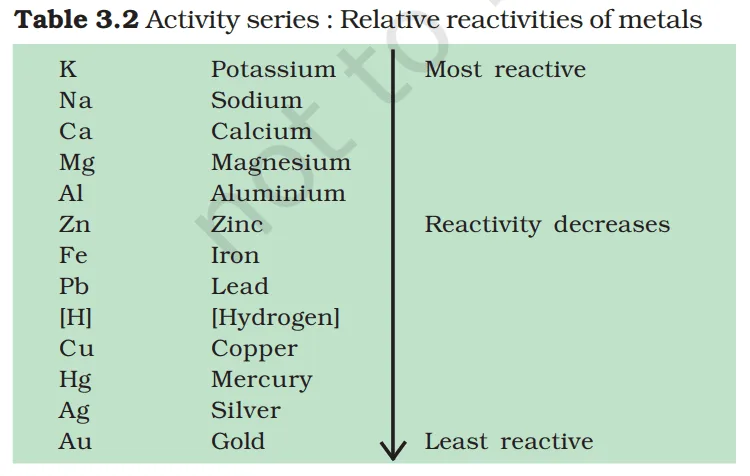
A metal placed above hydrogen in the activity series will displace hydrogen from water or acids. A metal placed at the top of the activity series would displace metal below it. Thus a more reactive metal displaces a less reactive metal from its salt solution.
Reaction of Metals and Non-metals
Formation of Sodium Chloride (NaCl)
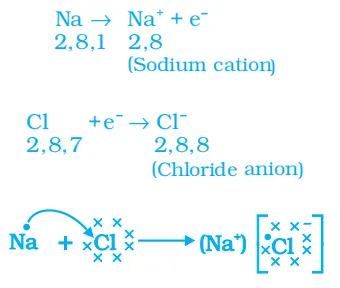
Sodium and chloride ions, being oppositely charged, attract each other and are held by strong electrostatic forces of attraction to exist as sodium chloride (NaCl).
Formation of Magnesium Chloride (MgCl2)
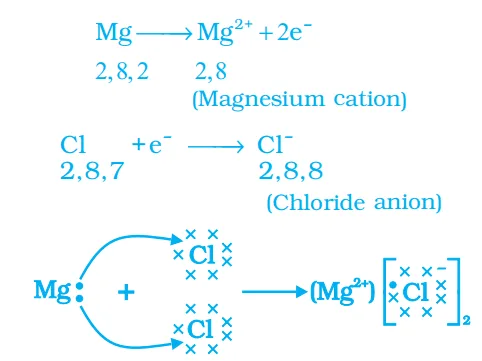
Ionic Compounds
Ionic compounds: The compounds formed by the transfer of electrons from a metal to a non-metal are called ionic compounds or electrovalent compounds.
Properties of ionic compounds:
- Physical nature: They are solid and hard, generally brittle.
- Melting and boiling point: They have high melting and boiling point.
- Solubility: Generally soluble in water and insoluble in solvents such as kerosene, petrol, etc.
- Conduction of electricity: Ionic compounds conduct electricity in molten and solution form but not in solid state.
Occurrence of Metals
Mineral: Natural occurring chemical substances obtained by mining.
Ore: An ore is a mineral from which metal is obtained.
Gangue: Ores mined from the earth are usually contaminated with large amounts of impurities such as soil, sand, etc., called gangue.
Extraction of Metals
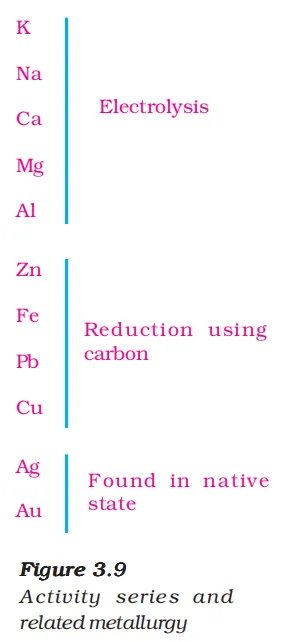
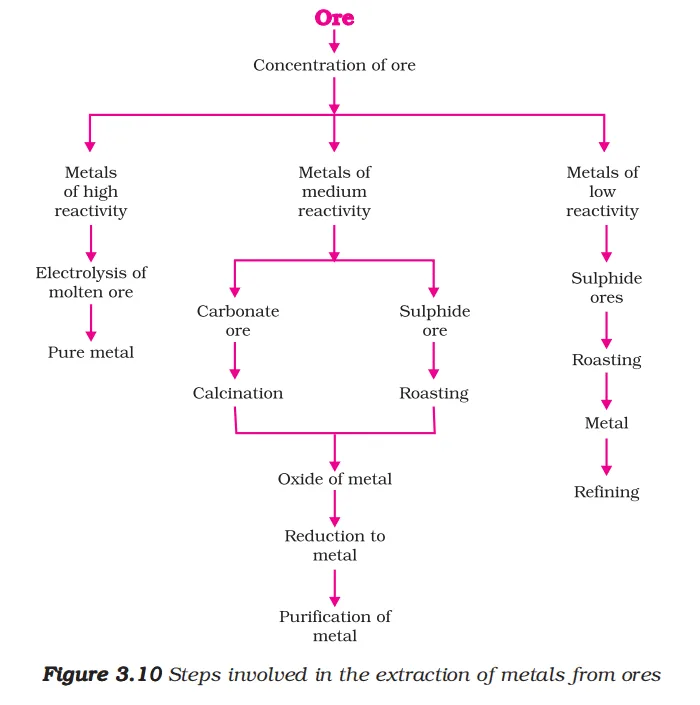
Extracting Metals Low in the Activity Series
Cinnabar (HgS) is an ore of mercury. When it is heated in air, it is first converted into mercuric oxide (HgO). Mercuric oxide is then reduced to mercury on further heating.
Roasting: 2HgS (s) + 3O2 (g) (Heat) → 2HgO (s) + 2SO2 (g)
Reduction: 2HgO (s) (Heat) → 2Hg (l) + O2 (g)
Copper which is found as Cu2S in nature can be obtained from its ore by just heating in air.

Extracting Metals in the Middle of the Activity Series
The metals in the middle of the activity series such as iron, zinc, lead, copper, are moderately reactive. These are usually present as sulphides or carbonates in nature.
| Roasting | Calcination |
| i. Ore is heated in the presence of air. | i. Ore is heated in the absence of air. |
| ii. It converts sulphide ores to oxide ores. | ii. It converts carbonate ores to oxide ores. |
| iii. For example: 2ZnS + 3O2 (heat) → 2ZnO + 2SO2 | iii. For example: ZnCO3 (heat) → ZnO + CO2 |
The metal oxides are then reduced to the corresponding metals by using suitable reducing agents such as carbon.
ZnO(s) + C(s) → Zn(s) + CO(g)
The highly reactive metals such as sodium, calcium, aluminium, etc., are used as reducing agents because they can displace metals of lower reactivity from their compounds. For example, when manganese dioxide is heated with aluminium powder, the following reaction takes place –
3MnO2(s) + 4Al(s) → 3Mn(l) + 2Al2O3(s) + Heat
These displacement reactions are highly exothermic. The amount of heat evolved is so large that the metals are produced in the molten state. In fact, the reaction of iron(III) oxide (Fe2O3) with aluminium is used to join railway tracks or cracked machine parts. This reaction is known as the thermit reaction.
Fe2O3(s) + 2Al(s) → 2Fe(l) + Al2O3(s) + Heat
Extracting Metals towards the Top of the Activity Series
For obtaining metals that are high in the reactivity series, their oxides are reduced to metals by the process of electrolysis.
For example The electrolysis of sodium chloride
At cathode: Na+ + e- → Na
At anode: 2Cl- → Cl2 + 2e-
Refining of Metals
The process of obtaining pure metal from its impure form is called the refining of metals.
Electrolytic refining of Copper:
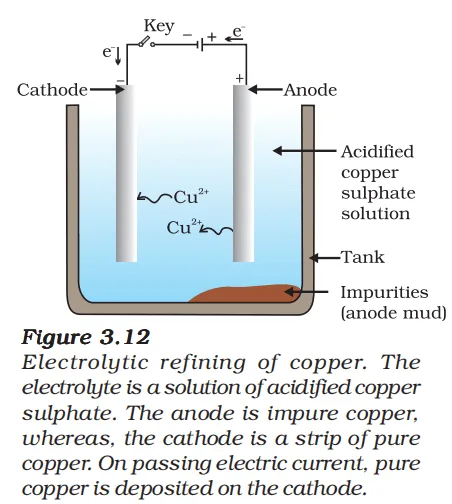
- Anode – Impure copper
- Cathode – Strip of pure copper
- Electrolyte – Solution of acidified copper sulphate
On passing the current through the electrolyte, the impure metal from the anode dissolves into the electrolyte.
Cu (Impure copper) → Cu2+ + 2e-
An equivalent amount of pure metal from the electrolyte is deposited at the cathode.
Cu 2+ + 2e- → Cu (Pure copper)
The insoluble impurities settle down at the bottom of the anode and is called anode mud.
Corrosion
- Silver articles become black after some time when exposed to air. This is because it reacts with sulphur in the air to form a coating of silver sulphide.
- Copper reacts with moist carbon dioxide in the air and slowly loses its shiny brown surface and gains a green coat. This green substance is basic copper carbonate.
- Iron when exposed to moist air for a long time acquires a coating of a brown flaky substance called rust.
- Iron articles need both air and water to rust.
Prevention of Corrosion
We can prevent the corrosion of iron by
- Painting
- Oiling and greasing
- Galvanization
- By making alloys.
Alloy: An alloy is a homogenous mixture of two or more metals or a metal and a non-metal.
Examples:
- Iron: Mixed with a small amount of carbon becomes hard and strong.
- Alloys are made to lower the melting point. Solder, an alloy of lead and tin has a lower melting point, so it is used for joining electrical wires together.
- Alloys are resistant to corrosion. Stainless steel which is made up of iron, chromium, and nickel resists corrosion. It is used for making utensils and surgical instruments.
The electrical conductivity of an alloy is less than that of pure metal.
🧲 Chapter 3: Metals and Non-metals – NCERT Solutions
📘 Intext Questions
🔹 Page 40
Q1. Give an example of a metal which:
-
(i) is a liquid at room temperature
-
(ii) can be easily cut with a knife
-
(iii) is the best conductor of heat
-
(iv) is a poor conductor of heat
✅ Answer:
-
(i) Mercury (Hg)
-
(ii) Sodium (Na)
-
(iii) Silver (Ag)
-
(iv) Lead (Pb)
Q2. Explain the meanings of malleable and ductile.
✅ Answer:
-
Malleable: Can be hammered into thin sheets (e.g., gold, silver)
-
Ductile: Can be drawn into thin wires (e.g., copper, aluminium)
🔹 Page 46
Q1. Why is sodium kept immersed in kerosene oil?
✅ Answer:
Sodium is highly reactive. It reacts vigorously with air and water. To prevent accidental reactions, it's stored in kerosene.
Q2. Write equations for the reactions of:
-
(i) iron with steam
-
(ii) calcium and potassium with water
✅ Answer:
-
(i)
-
(ii)
Q3. Samples of four metals A, B, C, and D were taken and added to the following solutions: A reacts with ZnSO₄ but not with FeSO₄. What is the order of reactivity?
✅ Answer:
Based on displacement:
Most reactive → Least reactive: A > Zn > Fe > B > C > D
Q4. Which gas is produced when a metal reacts with dilute hydrochloric acid? How can you test it?
✅ Answer:
Hydrogen gas is produced. Test: Bring a burning matchstick near the gas; it will burn with a pop sound.
🔹 Page 49
Q1. Name the metal which is found in liquid state at room temperature.
✅ Answer: Mercury (Hg)
Q2. Which metals do not corrode easily?
✅ Answer:
Gold and platinum are least reactive and do not corrode easily.
Q3. What are alloys?
✅ Answer:
An alloy is a homogeneous mixture of two or more metals or a metal and a non-metal to enhance properties (e.g., stainless steel = iron + chromium + nickel).
📙 NCERT Exercise Questions (Back of the Chapter)
🔹 Q1. Give an example of a metal that:
-
(i) is very hard
-
(ii) is soft and can be cut with a knife
-
(iii) is the best conductor of heat
-
(iv) is a poor conductor of heat
✅ Answer:
-
(i) Tungsten
-
(ii) Sodium
-
(iii) Silver
-
(iv) Lead
🔹 Q2. Explain the meanings of malleable and ductile.
✅ Answer:
Same as above (Page 40 answer)
🔹 Q3. Why is sodium kept immersed in kerosene oil?
✅ Answer:
Same as above (Page 46 answer)
🔹 Q4. Write equations for reactions of:
-
(a) Iron with steam
-
(b) Calcium and potassium with water
✅ Answer:
Same as above (Page 46 answer)
🔹 Q5. What would you observe when:
-
(a) Iron nails are placed in copper sulphate solution
-
(b) Copper is placed in iron sulphate solution
✅ Answer:
-
(a) Iron displaces copper; solution turns green, copper deposits on iron
-
(b) No reaction; copper is less reactive than iron
🔹 Q6. Which gas is produced when a metal reacts with dilute hydrochloric acid?
✅ Answer:
Hydrogen gas; burns with a pop sound.
🔹 Q7. What is an alloy?
✅ Answer:
Already covered (see Page 49)
📘 CBSE Previous Year & Sample Questions – Categorized by Marks
🔹 1-Mark Questions
-
Which gas is released when metals react with acids? How can you test it?
📅 CBSE 2020
✅ Answer: Hydrogen gas; test with a burning matchstick – it burns with a pop sound. -
Why is sodium stored under kerosene?
📅 CBSE 2023
✅ Answer: Sodium is highly reactive; it reacts with moisture/air, so it is stored in kerosene to prevent reactions. -
Name the metal which is:
-
a) the best conductor of electricity
-
b) found in a liquid state at room temperature
📅 CBSE 2018
✅ Answer:
a) Silver (Ag)
b) Mercury (Hg)
-
🔹 2-Mark Questions
-
Write chemical equations to show the reactions of:
-
a) Iron with steam
-
b) Calcium with water
📅 CBSE 2019
✅ Answer:
a) Fe + H₂O → Fe₃O₄ + H₂
b) Ca + 2H₂O → Ca(OH)₂ + H₂
-
-
What is an alloy? Write the composition of stainless steel.
📅 CBSE 2020
✅ Answer:
An alloy is a homogeneous mixture of metals.
Stainless steel = Iron + Chromium + Nickel
🔹 3-Mark Questions
-
State three physical properties each of:
-
a) Metals
-
b) Non-metals
📅 CBSE 2018
✅ Answer:
Metals: Malleable, ductile, good conductors of heat
Non-metals: Brittle, poor conductors, non-lustrous
-
-
Explain with an activity how metals displace other metals from salt solutions.
📅 CBSE 2022
✅ Answer:
Iron displaces copper from CuSO₄:
Fe + CuSO₄ → FeSO₄ + Cu
Observation: Blue color fades, brown copper deposits
🔹 4-Mark Questions (Assertion and Reason, Source-Based)
-
Assertion (A): Metals are good conductors of electricity.
Reason (R): Metals have free electrons.
📅 CBSE Sample Paper 2023
✅ Answer:
Both A and R are true, and R is the correct explanation of A. -
Case-based Question:
A student dropped a small piece of sodium in a beaker of water. He observed a vigorous reaction producing hydrogen gas.
Q1. Write the balanced chemical equation.
Q2. Why does sodium catch fire during the reaction?
Q3. What is the nature of the solution formed?
📅 CBSE Sample Paper 2024
✅ Answer:
-
2Na + 2H₂O → 2NaOH + H₂ ↑
-
Heat released ignites hydrogen
-
Basic (alkaline)
🔹 5-Mark Questions
-
Explain the steps involved in the extraction of metals from ores. Write the thermite reaction used for joining railway tracks.
📅 CBSE 2020
✅ Answer:
Steps:
-
Concentration of ore
-
Roasting or calcination
-
Reduction
-
Electrolytic refining
Thermite Reaction:
Fe₂O₃ + 2Al → 2Fe + Al₂O₃ + Heat
-
Define corrosion. Give two examples and explain two methods to prevent it.
📅 CBSE 2021
✅ Answer:
Corrosion: Gradual destruction of metals due to reaction with air/water
Examples: Rusting of iron, tarnishing of silver
Prevention: Galvanization, painting
📌 Frequently Asked Concepts in Board Exams
| Concept | Question Types | Frequency |
|---|---|---|
| Physical/Chemical Properties | 1M, 2M, 3M | High |
| Displacement Reactions | 2M, 3M, Case-based | High |
| Metal Reactions (Air, Water, Acid) | 1M, 2M, 3M | High |
| Alloys & Their Composition | 2M | Medium |
| Metallurgy (Ore to Metal) | 5M | Medium–High |
| Corrosion & Prevention | 3M, 5M | Medium |
| Assertion & Reason | 1M, 4M | Recent years |



Comments
Post a Comment